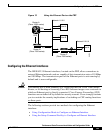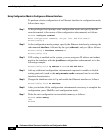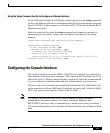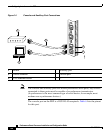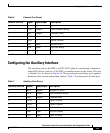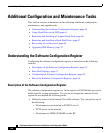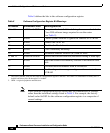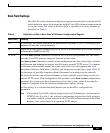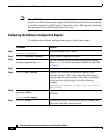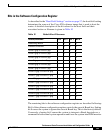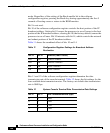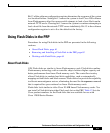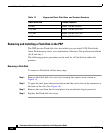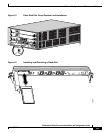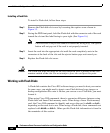
57
Performance Route Processor Installation and Configuration Guide
OL-11656-01
Additional Configuration and Maintenance Tasks
Boot Field Settings
Bits 00 to 03 of the software configuration register are referred to as the boot field,
which defines a source for booting the default Cisco IOS software image required
to run the router. The value of the boot field is specified as a binary number, as
described in Table 9.
Table 9 Definition of Bits in Boot Field of Software Configuration Register
Boot Field Meaning
00 On power up, the system remains at the ROM monitor prompt (
Rommon>), awaiting a user
command to boot the system manually.
01 On power up, the system automatically boots the first system image found in the onboard
Flash memory SIMM on the RP.
02 to 0F If a valid boot system command is stored in the NVRAM configuration file, the router
boots the Cisco IOS software image as directed by that value.
If no boot system command is present in the configuration file, the router forms a default
boot filename and attempts to acquire that file from a network TFTP server. To compute
the filename of this default image, the router starts with cisco and appends the octal
equivalent of the boot field value, a hyphen, and the processor type (grp or prp). Table 10
lists the range of possible computed default filenames for booting over the network.
The router would use one of these filenames to boot a default system image stored on a
network TFTP server. If the configuration file contains a valid boot system configuration
command, the system uses these instructions to boot the system, rather than using the
filename it computed from the software configuration register settings.
For this setting, it is assumed that the Ethernet port on the RP is configured and
operational.
Note If a bootable Cisco IOS software image exists in a Flash memory card inserted in
PCMCIA slot 0 or slot 1, the software configuration register boot field setting is
overridden, and the system boots from the Cisco IOS software image in the Flash
memory card, rather than from a network TFTP image.



